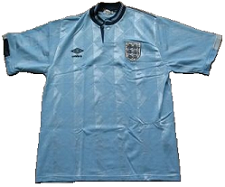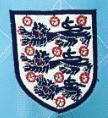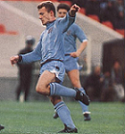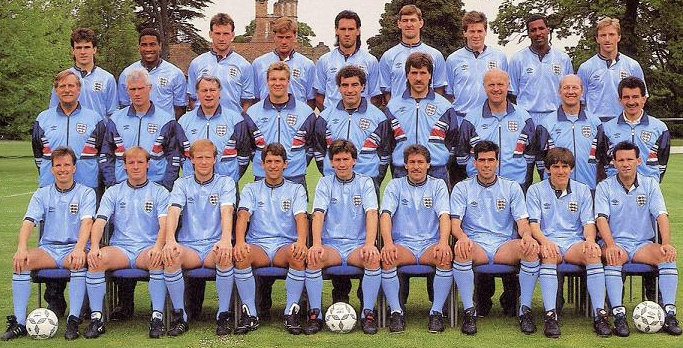|
|
 |
 Not worn in play Not worn in play |
|
Description |
 |
.JPG) |
|
|
|
Pale-blue short-sleeved shirt, with
square rhombus shadow stripes, each with a darker right half and all set
slightly to the left of an underlying diagonal grid. Navy-blue
crew-neck, with thin white stripe in middle and two thin red stripes
either side of it. White button on a navy-blue rectangular insert
beneath the neck, adjoining an overlapping white rectangular insert on the
inside of the shirt. Pale-blue underarm-half of hem, with outer white front
quarter and outer navy-blue back quarter on left sleeve, and outer navy-blue front quarter and outer white back quarter on right sleeve. Thin navy-blue stripe along
shoulder. Embroidered emblem on left breast. Two embroidered navy-blue
concentric diamonds on right breast, with 'umbro' in navy-blue
lower-case lettering underneath. Navy-blue numbers on back, in the same
font as on the previous Umbro England shirts, with a white
border, outlined in navy blue.
Pale-blue shorts, with white
drawstring, check
shadow pattern and navy-blue waistband. Thick white panel comprising lower
third of seams, joining two thin navy-blue stripes edging upper two-thirds
of seams, with a rectangular navy-blue block across the middle. Two embroidered
navy-blue concentric diamonds on left thigh, with 'umbro' in navy-blue
lower-case lettering underneath. Embroidered emblem on right thigh.
Pale-blue socks.
Solid white diamonds across tops, edged with two navy-blue hoops. |
|
Variations |
- A long-sleeved
version of the shirt was also produced. The cuffs were navy blue, with a thin white stripe in the middle and two thin
red stripes either side of it.
|
|
|

 Someone
at the Football Association was determined to re-introduce a pale-blue kit
to the England palette, obviously mindful of the
fondly-remembered all-sky-blue kit worn at the 1970 World Cup, against Czechoslovakia. Someone
at the Football Association was determined to re-introduce a pale-blue kit
to the England palette, obviously mindful of the
fondly-remembered all-sky-blue kit worn at the 1970 World Cup, against Czechoslovakia.
This is the only explanation for the persistent
attempts to establish pale blue as England's second-choice colour in the ten
years between 1986 and 1996. Firstly, at the World Cup in Mexico, pale-blue
shorts and socks were paired with the white shirt against Argentina, when
white shorts and red socks would have been the usual alternative, though,
just as in 1970, the lighter blue was taken as second choice because of
the hot climate.
Then, for the 1988 European Championship in
Germany, England were issued with this all-blue number. A
new red kit had also been introduced just before the tournament, in the
Rous Cup, against Colombia. This would have provided the perfect contrast to the white and navy-blue home kit,
but the new blue kit was, once again, taken as second choice, presumably
as a more comfortable option in a warm German summer.
Nevertheless, the FA persisted with the notion
that a pale-blue kit was required. This one did, at least, appear in an Under-21 fixture,
in Turkey, three years later. Both short and long-sleeved versions were worn in the same game.
Strangely enough, it was already redundant by then, as the full
international side wore the latest
pale-blue kit
on
the very next day.
Another blue kit
appeared in 1992, before the
indigo-blue kit
of 1996, which was officially launched as England's second choice without
there being a red alternative, finally
put paid to any pale-blue preferences when it was worn in the traumatic
shootout defeat against Germany. |
|
Match in which England Under-21 wore the
1988 Away Blue Uniform |
|
Season 1990-91 |
|
x |
Lawrie McMenemy |
|
UEFA Under-21 Championship preliminary match |
|
|
101 |
30 April 1991 -
Turkey 2
England
2 [1-1]
Alsancak Stadyumu, İzmir (2,000) |
Çam, Osman
Shearer, Campbell |
AD |
|
England: David James, J.Dodd, C.Vinnicombe, D.Lee, D.Blackwell, C.Tiler,
D.Hillier (G.Stuart), J.Ebbrell, Alan Shearer, I.Olney (K.Campbell),
R.Wallace. |

England face the camera in
their new blue kit at Bisham Abbey on June 6th, 1988, less than a week before
their disappointing European Championship campaign in Germany.
____________________
CG/GI
|
|